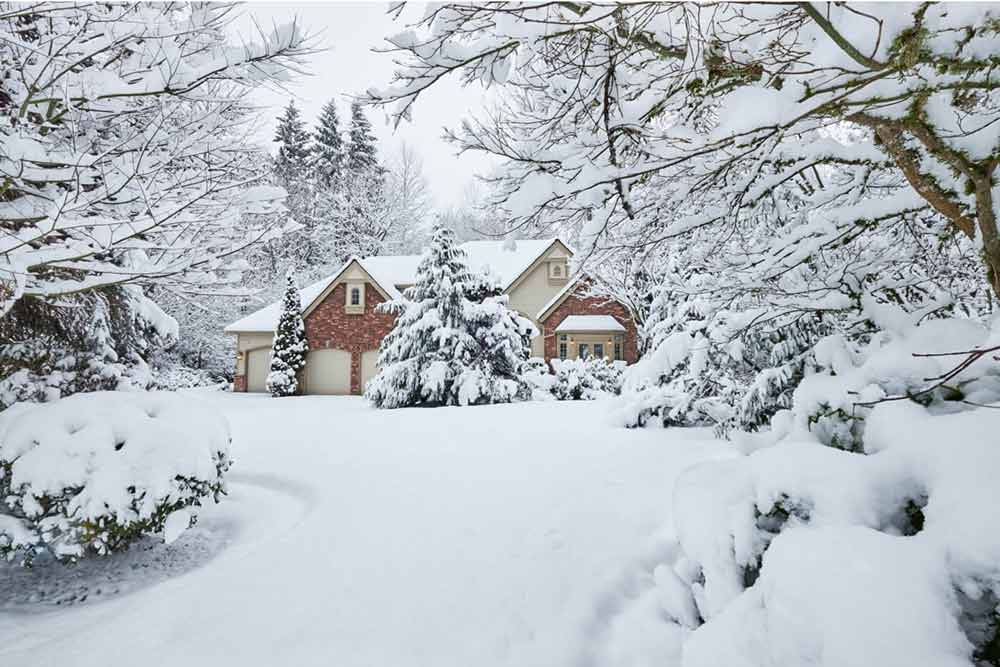How to prepare your house for winter Tips for preparing your garden and lawn for winter Tips for getting your pool and hot tub winter-ready Closing your pool: Closing your hot tub:
How to prepare your house for winter
1. Pad exposed pipes. Padding exposed pipes in unheated areas like basements and attics is a simple and inexpensive way to prevent damage caused by freezing. You can head over to your local hardware store and pick up some fiber glass pipe wrap or tubular pipe insulation to get the job done. Be diligent, even the small pipes left unpadded can cause a lot of damage.
2. Clean gutters and divert water. Prevent damage caused by leaks, flooding or ice dams by unclogging eavestroughs and gutters of any debris. Also, make sure your downspouts extend away from your house by at least 5 feet to divert water – this will prevent foundation erosion and reduce the risk of basement flooding.
3. Inspect the roof. Check your roof for any missing or damaged shingles; if your roof is flat, try using a leaf blower to remove debris. If you find any problems, it’s a good idea to call a roofer and get professional help with repairs.
4. Turn off outdoor faucets. Disconnecting and draining things like your garden hose, sprinklers and lawn irrigation system will prevent water freezing and bursting pipes.
5. Winterize your air conditioner. Preparing your central air conditioner against harsh winter elements will prevent damage (like rust), and keep it in perfect condition for spring. After turning it off for the season, remove any debris, pad the exposed pipes and secure a waterproof cover over it.
Tips for preparing your garden and lawn for winter
1. Mowing. Try not to choose a final date for mowing. You should keep your mowing schedule going to keep your grass as short as possible until the first freeze of the season. Maintaining your lawn this way will help protect new, fragile grass and avoid dead spots come spring.
2. Aeration. Aerating is the process of making small holes in soil to allow nutrients, water and air to reach grass roots. You can buy or rent an aerator from your nearest garden center to complete the process in a few hours. Aerating soil before the first freeze of the season helps to promote a better environment for grass growth, ensuring a beautiful lawn in the spring.
3. Leaves and bushes. Raking and mulching leaves before winter are the two best ways to prevent dead spots and bare ground in the spring. If you choose to mulch, mow the leaves first instead of raking them, so they can decompose and nourish the lawn. You should also try trimming overgrown bushes and trees near your house and electrical wires to reduce the risk of power issues and property damaged caused by fallen branches.
4. Storing your lawn mower. Leaving fuel in your mower’s engine over the winter will cause it to decompose and potentially damage your engine. Try using up all the fuel during the last mow of the season and keep it running outside after to get rid any leftovers. It’s also a good idea to double check your mower’s manual for specific winter storage advice.
5. Removing yard accessories. Leaving toys and lawn furniture out on the lawn over winter could stunt grass growth and leave dead spots – avoid this by placing your lawn accessories in the garage or shed for the season.
Tips for getting your pool and hot tub winter-ready
Closing your pool:
While the season for swimsuits and poolside siestas may be over, you should try waiting until the pool water is consistently under 15 degrees Celsius before closing – this will help prevent algae build up. When you’re ready, take these closing steps to protect your pool from damage:
- 1. Remove things like diving boards, ropes, and hand rails. Also, make sure to clear the water of any debris.
- 2. Get the chemicals tested and balanced by a professional. Doing this before winter helps protect your pool lining from damage and staining.
- 3. Drain the pool and winterize equipment. To prevent ice damage, lower the water level a few inches below the skimmer.
- 4. Cover your pool. Use a cover that’s in good condition and have it properly installed. This will keep your pool clear of debris, preventing algae and wasted time cleaning in the spring.
Closing your hot tub:
While it’s exhilarating to enjoy sitting in a hot tub surrounded by snow, it comes with extra heating costs and ongoing maintenance. If you aren’t planning on using your hot tub much this winter, it may be a good idea to close it. Here are some tips for closing it properly:
- 1. Drain and flush the system. Leaving water in your hot tub that’s not heated and circulated could result in damage to its plumbing system. Ensure you’ve completely drained the tub and the system of any water first.
- 2. Remove filters. This is a great time to clean out the filters and store them for the winter so they’re ready to go in the spring.
- 3. Run air blowers and jets. Turn them on for 1 minute to blow any remaining water out of the air channels.
- 4. Clean out the interior. Scrub down the walls and floor of the tub with an approved cleaner. Make sure everything is completely dry before moving to the next step!
- 5. Secure the hard cover and attach a tarp. Placing a waterproof tarp over the hard cover can help reduce wear from the elements, especially if your hot tub is wooden.
